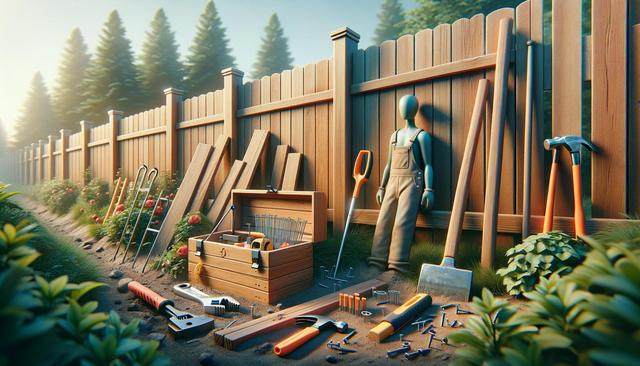Understanding Common Fence Issues
Before tackling any repair job, it’s important to identify the type of damage your fence is facing. Common issues include loose or broken boards, rusted nails, leaning posts, and general wear from weather exposure. Learning how to repair fence problems starts with a thorough inspection. Walk along the entire length of your fence and take note of areas that need attention. If you see signs of rotting wood, corroded metal, or sagging sections, these should be addressed promptly to prevent further damage.
Some smaller issues can be managed without the need for professional fence repair services. For example, replacing a single broken board or tightening loose screws can often be done with basic tools. However, larger problems like leaning fences or widespread rot might require more advanced skills or even partial fence replacement. Keeping your fence in good condition through regular checks helps minimize the need for bigger repairs later on.
Tools and Materials You’ll Need
Having the right tools and materials on hand can make your fence repair process much smoother. Whether you’re dealing with wood, vinyl, or metal fencing, preparation is key. Here’s a general list of tools you’ll likely need:
- Hammer or power drill
- Screwdrivers
- Replacement screws or nails
- Level and measuring tape
- Wood filler or epoxy (for wooden fences)
- Protective gloves and safety glasses
When selecting materials, be sure to match existing parts for a consistent look and structural integrity. Use pressure-treated wood for outdoor wooden fences, and make sure any metal parts are galvanized or rust-resistant. Vinyl fences may require specialized connectors or brackets, which can be found at most home improvement stores. Understanding the appropriate materials for your specific fence type ensures a more durable repair and reduces the need for future fence replacement.
Step-by-Step Guide to Basic Fence Repair
Once you’ve gathered your tools and materials, you can start the repair process. Here’s a simple guide on how to repair fence damage in a few common scenarios:
- Loose boards: Remove the old nails or screws, reposition the board, and secure it with new fasteners.
- Rotting wood: Cut out the damaged section and replace it with a new, treated piece. Use wood filler for minor rot.
- Leaning posts: Dig around the base, straighten the post, and reinforce it with concrete or gravel for stability.
Make sure to use a level to ensure all parts are aligned properly. For wooden fences, apply a sealant or paint after repairs to protect against moisture and UV damage. Regular maintenance like this not only extends the life of your fence but also reduces the need to call in fence repair services for more extensive issues.
Maintaining Your Fence for Long-Term Durability
Proper maintenance can greatly extend the life of your fence and reduce the frequency of repairs. Begin by cleaning your fence at least once a year. For wood, use a mild detergent and water to remove grime. Metal fences may need rust removal and a protective coat of paint, while vinyl fences benefit from occasional washing to prevent discoloration.
In addition to cleaning, consider these maintenance tips:
- Inspect your fence after storms or heavy winds for any visible damage
- Trim vegetation near the fence to prevent moisture buildup and pests
- Reapply paint or sealant every few years for wooden fences
- Check for loose fasteners and tighten them as needed
These small steps can help you avoid the need for fence replacement by keeping your current structure in good condition. If you’re unsure how to perform certain maintenance tasks, fence repair services can provide professional guidance or handle the work for you.
Considering Fence Installation and Replacement
Sometimes, despite your best efforts, a fence may be beyond repair. In such cases, fence replacement becomes the more practical option. Signs that replacement might be necessary include extensive rot, multiple leaning posts, or outdated materials that no longer meet your needs. If you’re considering a full fence installation, the first step is to choose the right type of fence for your property.
Popular fencing materials include:
- Wood: Offers a classic look and can be customized, but requires regular maintenance
- Vinyl: Low-maintenance and weather-resistant, ideal for long-term durability
- Metal: Strong and secure, often used for more industrial or high-security areas
When planning a new fence installation, also consider factors like local regulations, property lines, and your specific needs—whether it’s privacy, security, or aesthetic appeal. Professional fence repair services can often assist with installation, ensuring the job is done properly and safely. Even if you decide to handle it yourself, a clear plan and quality materials will lead to better results.
Conclusion: Taking Control of Your Fence Care
Repairing and maintaining your fence doesn’t have to be overwhelming, even for beginners. With the right tools, materials, and a bit of patience, many common issues can be resolved without outside help. By learning how to repair fence damage, staying on top of maintenance, and understanding when fence replacement is necessary, you can keep your fencing in excellent shape for years to come.
Whether you choose to tackle repairs independently or opt for professional fence repair services, taking a proactive approach will save time and money in the long run. And for those considering a new fence installation, thoughtful planning and material selection are key to building a structure that serves your goals and stands up to the elements.
